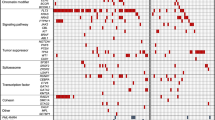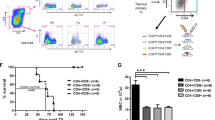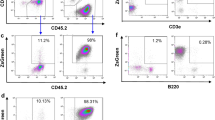Abstract
Xenograft models of chronic phase human chronic myeloid leukemia (CML) have been difficult to develop because of the persistence of normal hematopoietic stem cells in most chronic phase CML patients and the lack of methods to selectively isolate the rarer CML stem cells. To circumvent this problem, we first identified nine patients' samples in which the long-term culture-initiating cells were predominantly leukemic and then transplanted cells from these samples into sublethally irradiated NOD/SCID and NOD/SCID-β2microglobulin−/− mice. This resulted in the consistent and durable (>5 months) repopulation of both host genotypes with similar numbers of BCR-ABL+/Ph+ cells. The regenerated leukemic cells included an initial, transient population derived from CD34+CD38+ cells as well as more sustained populations derived from CD34+CD38− progenitors, indicative of a hierarchy of transplantable leukemic cells. Analysis of the phenotypes produced revealed a reduced output of B-lineage cells, enhanced myelopoiesis with excessive production of erythroid and megakaropoietic cells and the generation of primitive (CD34+) leukemic cells displaying an autocrine IL-3 and G-CSF phenotype, all characteristics of primary CML cells. These findings demonstrate the validity of this xenograft model of chronic phase human CML, which should enable future investigation of disease pathogenesis and new approaches to therapy.
This is a preview of subscription content, access via your institution
Access options
Subscribe to this journal
Receive 12 print issues and online access
$259.00 per year
only $21.58 per issue
Buy this article
- Purchase on Springer Link
- Instant access to full article PDF
Prices may be subject to local taxes which are calculated during checkout



Similar content being viewed by others
References
Rowley JD . A new consistent chromosomal abnormality in chronic myelogenous leukaemia identified by quinacrine fluorescence and Giemsa staining. Nature 1973; 243: 290–293.
Eaves CJ, Eaves AC . Progenitor cell dynamics. In: Carella AM, Daley GQ, Eaves CJ, Goldman JM, Hehlmann R (eds). Chronic Myeloid Leukemia: Biology & Treatment. London: Martin Dunitz, 2001, pp 73–100.
Petzer AL, Eaves CJ, Lansdorp PM, Ponchio L, Barnett MJ, Eaves AC . Characterization of primitive subpopulations of normal and leukemic cells present in the blood of patients with newly diagnosed as well as established chronic myeloid leukemia. Blood 1996; 88: 2162–2171.
Holyoake T, Jiang X, Eaves C, Eaves A . Isolation of a highly quiescent subpopulation of primitive leukemic cells in chronic myeloid leukemia. Blood 1999; 94: 2056–2064.
Christianson SW, Greiner DL, Hesselton R, Leif JH, Wagar EJ, Schweitzer IB et al. Enhanced human CD4+ T cell engraftment in β2-microglobulin-deficient NOD-scid mice. J Immunol 1997; 158: 3578–3586.
Wang JCY, Dorrell C, Ito CY, Inamitsu T, Guenechea G, Gan OI et al. Normal and leukemic human stem cells assayed in immune-deficient mice. In: Zon LI (ed). Hematopoiesis: a Developmental Approach. New York: Oxford University Press, 2001, pp 99–118.
Glimm H, Eisterer W, Lee K, Cashman J, Holyoake TL, Nicolini F et al. Previously undetected human hematopoietic cell populations with short-term repopulating activity selectively engraft NOD/SCID-β2 microglobulin-null mice. J Clin Invest 2001; 107: 199–206.
Maguer-Satta V, Petzer AL, Eaves AC, Eaves CJ . BCR-ABL expression in different subpopulations of functionally characterized Ph+ CD34+ cells from patients with chronic myeloid leukemia. Blood 1996; 88: 1796–1804.
Jiang X, Lopez A, Holyoake T, Eaves A, Eaves C . Autocrine production and action of IL-3 and granulocyte colony-stimulating factor in chronic myeloid leukemia. Proc Natl Acad Sci USA 1999; 96: 12804–12809.
Oh I-H, Lau A, Eaves CJ . During ontogeny primitive (CD34+CD38−) hematopoietic cells show altered expression of a subset of genes associated with early cytokine and differentiation responses of their adult counterparts. Blood 2000; 96: 4160–4168.
Waye S, Willard H . Structure, organization and sequence of alpha satellite DNA from human chromosome 17: evidence for evolution by unequal crossing-over and an ancestral pentamer repeat shared with the human X chromosome. Mol Cell Biol 1986; 6: 3156–3165.
Heisterkamp N, Stam K, Groffen J, De Klein A, Grosveld G . Structural organization of the bcr gene and its role in the Ph1 translocation. Nature 1985; 315: 758–761.
Hogge DE, Lansdorp PM, Reid D, Gerhard B, Eaves CJ . Enhanced detection, maintenance and differentiation of primitive human hematopoietic cells in cultures containing murine fibroblasts engineered to produce human Steel factor, interleukin-3 and granulocyte colony-stimulating factor. Blood 1996; 88: 3765–3773.
Fraser C, Eaves CJ, Kalousek DK . Fluorodeoxyuridine synchronization of hemopoietic colonies. Cancer Genet Cytogenet 1987; 24: 1–6.
Chalandon Y, Jiang X, Christ O, Loutet S, Thanopoulou E, Eaves A, Eaves C . BCR-ABL-transduced human cord blood cells produce abnormal populations in immunodeficient mice. Leukemia 2005; 19: 442–448.
Cashman JD, Lapidot T, Wang JCY, Doedens M, Shultz LD, Lansdorp P et al. Kinetic evidence of the regeneration of multilineage hematopoiesis from primitive cells in normal human bone marrow transplanted into immunodeficient mice. Blood 1997; 89: 4307–4316.
Holyoake TL, Nicolini FE, Eaves CJ . Functional differences between transplantable human hematopoietic stem cells from fetal liver, cord blood, and adult marrow. Exp Hematol 1999; 27: 1418–1427.
Bedi A, Zehnbauer BA, Barber J, Sharkis S, Jones R . Inhibition of apoptosis by BCR-ABL in chronic myeloid leukemia. Blood 1994; 83: 2038–2044.
Ailles LE, Gerhard B, Kawagoe H, Hogge DE . Growth characteristics of acute myelogenous leukemia progenitors that initiate malignant hematopoiesis in nonobese diabetic/severe combined immunodeficient mice. Blood 1999; 94: 1761–1772.
Eisterer W, Jiang X, Bachelot T, Pawliuk R, Abramovich C, Leboulch P et al. Unfulfilled promise of endostatin in a gene therapy-xenotransplant model of human acute lymphocytic leukemia. Mol Ther 2002; 5: 352–359.
Ichimaru M, Ishimaru T, Mikami M, Yamada Y, Ohkita T . Incidence of leukemia in a fixed cohort of atomic bomb survivors and controls, Hiroshima and Nagasaki October 1950–December 1978: Technical Report RERF TR 13-81. Hiroshima: Radiation Effects Research Foundation, 1981.
Socie G, Curtis RE, Klein JP . Late complications, including late relapse. In: Carella A, Daley GQ, Goldman JM, Hehlmann R (eds). Chronic Myeloid Leukaemia Biology and Treatment. London, UK: Martin Dunitz, 2001, pp 401–417.
Magli MC, Iscove NN, Odartchenko N . Transient nature of early haematopoietic spleen colonies. Nature 1982; 295: 527–529.
Akashi K, Traver D, Miyamoto T, Weissman IL . A clonogenic common myeloid progenitor that gives rise to all myeloid lineages. Nature 2000; 404: 193–197.
Jordan CT, Lemischka IR . Clonal and systemic analysis of long-term hematopoiesis in the mouse. Genes Dev 1990; 4: 220–232.
Uchida N, Dykstra B, Lyons KJ, Leung FYK, Eaves CJ . Different in vivo repopulating activities of purified hematopoietic stem cells before and after being stimulated to divide in vitro with the same kinetics. Exp Hematol 2003; 31: 1338–1347.
Morrison SJ, Weissman IL . The long-term repopulating subset of hematopoietic stem cells is deterministic and isolatable by phenotype. Immunity 1994; 1: 661–673.
Ortiz M, Wine JW, Lohrey N, Ruscetti FW, Spence SE, Keller JR . Functional characterization of a novel hematopoietic stem cell and its place in the c-kit maturation pathway in bone marrow cell development. Immunity 1999; 10: 173–182.
Kerre TC, De Smet G, De Smedt M, Offner F, De Bosscher J, Plum J, Vandekerckhove B . Both CD34+38+ and CD34+38- cells home specifically to the bone marrow of NOD/LtSZ scid/scid mice but show different kinetics in expansion. J Immunol 2001; 167: 3692–3698.
Hogan CJ, Shpall EJ, Keller G . Differential long-term and multilineage engraftment potential from subfractions of human CD34+ cord blood cells transplanted into NOD/SCID mice. Proc Natl Acad Sci USA 2002; 99: 413–418.
Conneally E, Cashman J, Petzer A, Eaves C . Expansion in vitro of transplantable human cord blood stem cells demonstrated using a quantitative assay of their lympho-myeloid repopulating activity in nonobese diabetic-scid/scid mice. Proc Natl Acad Sci USA 1997; 94: 9836–9841.
Bhatia M, Wang JCY, Kapp U, Bonnet D, Dick JE . Purification of primitive human hematopoietic cells capable of repopulating immune-deficient mice. Proc Natl Acad Sci USA 1997; 94: 5320–5325.
Civin CI, Almeida-Porada G, Lee M-J, Olweus J, Terstappen LWMM, Zanjani ED . Sustained, retransplantable, multilineage engraftment of highly purified adult human bone marrow stem cells in vivo. Blood 1996; 88: 4102–4109.
Kollet O, Peled A, Byk T, Ben-Hur H, Greiner D, Shultz L et al. β2 microglobulin-deficient (B2mnull) NOD/SCID mice are excellent recipients for studying human stem cell function. Blood 2000; 95: 3102–3105.
Zhang X, Ren R . BCR-ABL efficiently induces a myeloproliferative disease and production of excess interleukin-3 and granulocyte-macrophage colony-stimulating factor in mice: a novel model for chronic myelogenous leukemia. Blood 1998; 92: 3829–3840.
Li S, Ilaria RL, Million RP, Daley GQ, Van Etten RA . The p190, p210, and p230 forms of the BCR/ABL oncogene induce a similar chronic myeloid leukemia-like syndrome in mice but have different lymphoid leukemogenic activity. J Exp Med 1999; 189: 1399–1412.
Jiang X, Ng E, Yip C, Eisterer W, Chalandon Y, Stuible M et al. Primitive interleukin 3 null hematopoietic cells transduced with BCR-ABL show accelerated loss after culture of factor-independence in vitro and leukemogenic activity in vivo. Blood 2002; 100: 3731–3740.
Chalandon Y, Jiang X, Loutet S, Eaves AC, Eaves CJ . Growth autonomy and lineage switching in BCR-ABL-transduced human cord blood cells depend on different functional domains of BCR-ABL. Leukemia 2004; 18: 1006–1012.
Acknowledgements
We are grateful to colleagues in Bangkok, Thailand; Columbus, OH; Glasgow, Scotland; Houston, TX; Innsbruck, Austria and Vancouver, BC who contributed the patient samples used, the staff of the Stem Cell Assay and FACS facility of the Terry Fox Laboratory for technical assistance, Dr N Heisterkamp (Childrens Hospital, Los Angeles, CA) for the BCR probe, Dr J Dick (Hospital for Sick Children, Toronto, Ontario, Canada) for the P17H8 probe and Dr P Lansdorp (Terry Fox Laboratory) and StemCell Technologies (Vancouver, BC, Canada) for antibodies and culture reagents. The secretarial help of Adrienne Wanhill is also acknowledged. This work was supported by grants from the Cancer Research Society and the Leukemia Research Fund of Canada (to XJ) and the National Cancer Institute of Canada with funds from the Canadian Cancer Society (to AE and CE). W Eisterer was supported by a grant from the Fonds zur Foderung der Wissenschaftlichen Forschung (J17777-MED), O Christ by a German Research Foundation Fellowship and H Glimm by funds from the Mildred Scheel Stiftung fur Krebsforschung, Bonn, Germany and the Verein zur Foerderung der Leukaemie und Tumorforschung, Freiburg, Germany.
Author information
Authors and Affiliations
Corresponding author
Additional information
Supplementary Information
Supplementary Information accompanies the paper on the Leukemia website (http://www.nature.com/leu)
Supplementary information
Rights and permissions
About this article
Cite this article
Eisterer, W., Jiang, X., Christ, O. et al. Different subsets of primary chronic myeloid leukemia stem cells engraft immunodeficient mice and produce a model of the human disease. Leukemia 19, 435–441 (2005). https://doi.org/10.1038/sj.leu.2403649
Received:
Accepted:
Published:
Issue Date:
DOI: https://doi.org/10.1038/sj.leu.2403649
Keywords
This article is cited by
-
Eliminating chronic myeloid leukemia stem cells by IRAK1/4 inhibitors
Nature Communications (2022)
-
Phenotypic characterization of leukemia-initiating stem cells in chronic myelomonocytic leukemia
Leukemia (2021)
-
In Vitro Comparison of the Effects of Imatinib and Ponatinib on Chronic Myeloid Leukemia Progenitor/Stem Cell Features
Targeted Oncology (2020)
-
Chronic myeloid leukemia stem cells
Leukemia (2019)
-
Identification of a leukemia-initiating stem cell in human mast cell leukemia
Leukemia (2019)



